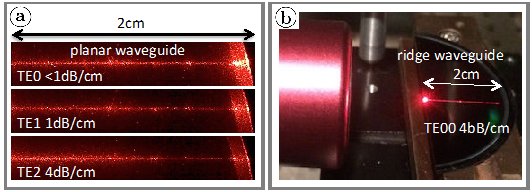Non-linear optics
Light is associated with an electromagnetic field, including an electric
and magnetic components. Other electric fields exist, of various origins,
which can come from the internal structure of certain materials or
even result from the application of a voltage.
Nonlinear optics in a broad sense includes all of optical phenomena
with a nonlinear response in terms of these electric fields. If it
is an interaction between the electromagnetic field and an applied
field, one speaks of electro-optical effects. If nonlinear effects
are related to electromagnetic fields only, one speaks then of nonlinear
optics in the strict sense, with conversions of wavelengths (harmonic
generation, parametric fluorescence) or still effects of index variation
leading to the self-focusing or self-defocusing of a beam, etc...
CRHEA interest mainly lies in the conversion of wavelengths from a
second order non-linear effect: second harmonic, sum and difference
frequency generation and parametric fluorescence. In the first case,
two hν photons create a h2ν photon. In the latter case, one
hν photon splits into two photons (hν1 and hν2)
such as hν = hν1 + hν2.
These processes are involved only in media which have no center of
symmetry, and where, to a certain level of excitement, the polarization
of the material, presents significant non-linear terms and can thus
lead to new electrical fields whose frequencies are the sum or the
difference of the frequencies of the incident beams...
At CRHEA, the nonlinear material is gallium nitride (GaN) and its
(AlGaN) alloys and the research focuses on the second harmonic generation.
An important goal is to take advantage of the transparency of these
materials in the ultraviolet to achieve coherent UV sources starting
from visible laser easily accessible such as InGaN laser diodes emitting
between 400 and 500 nm. The non-linear conversion is achieved by interaction
between optical modes propagating in thin structures called waveguides
in which one can reach high power densities for relatively low incident
powers.
For the experimental realization, the first difficulty is to get low-loss
propagation guides (<1dB/cm). In the visible, the scattering by
the roughness of the interfaces and surfaces becomes a severe problem.
We have established that this scattering is the limiting factor if
one does not take a particular care to get smooth surfaces. A significant
dislocation density in the first layers of nitrides on sapphire may
also introduce significant losses. In the end, we have developed a
technique that combines molecular beam epitaxy and vapor phase epitaxy
and allows minimizing roughness on a large and on a small lateral
scale. As a result, we got losses less than 1 dB/cm for the fundamental
mode and barely more for higher orders.

The second difficulty is to get the phase matching between modes coupled by the non-linear effect. Second harmonic generation is done throughout the guide, and we must ensure that after a certain distance of propagation, the harmonic wave created at the beginning of the guide and propagating to a given point along the guide is not found in phase opposition with the harmonic generated at this point. Therefore, one must find a way to make the pump and harmonic waves propagate at the same speed, with the same optical index. As the index varies with wavelength, the problem seems intractable. But we can take advantage of the variation of the effective index with other factors such as the shape of the optical mode, to counterbalance the variation with wavelength: this is the modal phase matching. In GaN/AlGaN waveguides, we can find such a modal phase matching. It can also be found in the microdisks with modes propagating along the periphery of the disc (whispering gallery modes). We can finally find it in resonant cavities such as photonic crystals. All of these structures have been studied and we demonstrated the generation of second (or even third) harmonic. For the time being, the best conversion efficiencies were obtained in wave guides and are in the order of 2%.

and photonic crystals (c)


